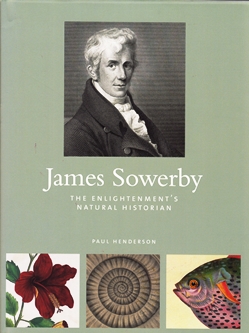 James Sowerby (1757-1822) was the fourth surviving son of a successful lapidary with a business near Fleet Street in London. Showing promise in sketching, he was apprenticed to a painter, Richard Wright, in 1771. Alas! Wright suffered a stroke and died in 1775. An attempt to replace him with William Hodges did not last long, but Hodges had been the official artist on James Cook’s second voyage (1772-1775) which gave James a glimpse of the preparation of engraved illustrations for the book of the expedition.
James Sowerby (1757-1822) was the fourth surviving son of a successful lapidary with a business near Fleet Street in London. Showing promise in sketching, he was apprenticed to a painter, Richard Wright, in 1771. Alas! Wright suffered a stroke and died in 1775. An attempt to replace him with William Hodges did not last long, but Hodges had been the official artist on James Cook’s second voyage (1772-1775) which gave James a glimpse of the preparation of engraved illustrations for the book of the expedition.
Notwithstanding his truncated apprenticeship, James by now had enough skill as a painter to sell his work. His lucky break came about 1776. William Curtis, an apothecary turned botanist, was preparing his Flora Londinensis (1777-1798) with 432 hand-coloured engraved plates. Several artists were involved, and it is not clear when Sowerby began to contribute; but when he did, he had mastered the style of drawing, engraving and colouring illustrations of plant specimens. His manifest skill led to numerous requests to supply botanical illustrations.
The Flora was issued in small parts, each with a few plates. Species were illustrated as material became available, so there was no overall plan. Parts had to be collected and bound up at the buyer’s expense. The advantage was that minimal capital investment was needed. All the major works with which Sowerby was involved were published in this way, and it became a speciality of the family business, which he founded.
In February 1786 James married Anne de Carle. His father in law gave the couple a house, 2 Mead Place, Lambeth, which remained James’s home and place of business for the rest of his life. A museum was built at the back about 1796 and the house next door was eventually added.
Sowerby had become a competent botanist and now launched English botany (1790-1814), with 2592 coloured plates, on his own initiative. The enterprise was a success, the later parts, at least, selling about 900 copies.
Towards the end of the century he branched out, publishing British Mineralogy (1802-1817, five volumes) and starting Mineral Conchology (i.e. fossils), 1812-1846, completed by his son James de Carle, as well as other mineralogical and conchological books.
Paul Henderson has given us a comprehensive account of Sowerby’s life and work, with reference to the social and intellectual background of the time. It is lavishly illustrated, chiefly with Sowerby’s own engravings.
Reviewed by Desmond Donovan
JAMES SOWERBY: THE ENLIGHTENMENT’S NATURAL HISTORIAN by PAUL HENDERSON. 2015. Richmond, Royal Botanic Gardens, Kew, 331 pp.
ISBN 978 1 84246 596 7 List Price £35.00. W: www.shop.kew.org/